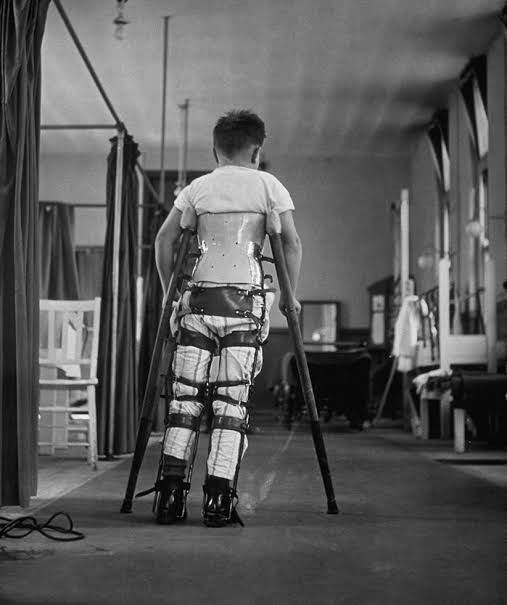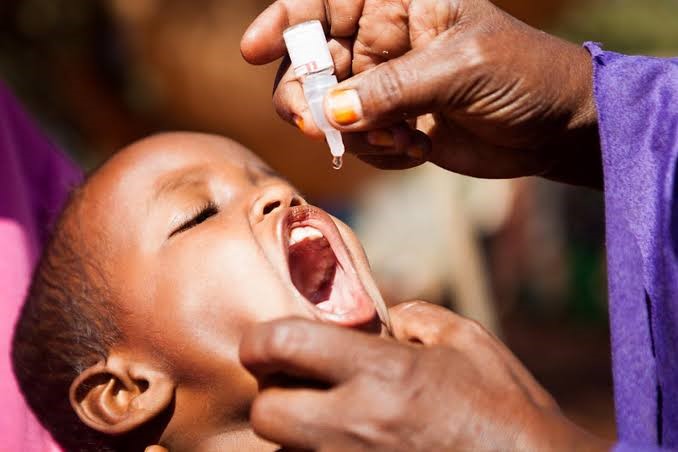What is Poliomyelitis?
Poliomyelitis, commonly called ‘Polio’, is a highly infectious disease with disabling and life-threatening complications, known to be caused by a virus that invades and destroys the cells of the nervous system, causing paralysis, mainly among children under 5 years of age. The disease is prone to causing widespread epidemics, reflected by the fact that as long as a single child remains infected in a particular region, all children in that region are at risk of contracting the disease. Failure to eradicate polio from any country can result in as many as 200,000 new cases every year within the next ten years.
What causes Poliomyelitis?
Polio is caused by a highly infectious virus called the Wild Poliovirus (WPV), which invades the nervous system and can cause total paralysis in a matter of hours, mainly in the lower extremities (legs). The virus is transmitted from one individual to another mainly through the faeco-oral route, or less frequently, through common mediums such as contaminated food and water. On very rare occasions, the disease can be transmitted through a sneeze or cough, as the virus resides in the throat and intestines of infected persons. Upon entry into the gastrointestinal tract, the virus multiplies in the intestines and invades the local network of nerves (enteric plexus), from which it spreads to the central nervous system (specifically the spinal cord and sometimes, the brain). This can cause meningitis (inflammation of the protective layers of the brain and spinal cord), and is the particular cause of paralysis in a fraction of infected individuals.
What are the Signs and Symptoms of Polio?
It has been observed that a major percentage of people that contract the poliovirus are asymptomatic, a condition known as ‘subclinical polio’. Asymptomatic persons can actually spread the virus to other individuals even without the presence of symptoms, which is the reason why the frequency of disease transmission is high. There are three main types of polio disease, which are Abortive polio, Non-paralytic polio and Paralytic polio. Abortive polio is the mildest form of polio, exhibiting the least severe symptoms. It is termed ‘abortive’ because the symptoms usually resolve with time and rarely progress to complications. The symptoms of abortive polio include fever, loss of appetite, nausea and vomiting, sore throat, fatigue, abdominal pains and constipation. In Non-paralytic polio, the symptoms are a bit more advanced, with worsened nausea and vomiting, and signs of meningitis such as painful headaches, pain and stiffness in the neck and along the spine, as well as body aches, especially in the trunk, arms and legs. The symptoms of Non-paralytic polio can last between 1 to10 days. In about 2% of polio cases, the disease can progress to Paralytic polio, which is the phase where signs of paralysis manifest. The symptoms include severe constipation, loss of reflexes, severe muscle pain and spasms, muscle weakness and wasting, difficulty swallowing, development of floppy and deformed limbs, and sudden paralysis of muscles (temporary or permanent). Less than 1% of polio cases will result in total and permanent paralysis (usually in the legs). In 5-10% of the cases of polio paralysis, death by suffocation will occur due to paralysis of the muscles responsible for breathing.

How is Polio diagnosed?
The diagnosis of Poliomyelitis is mainly based on the manifestation of symptoms. Cases of asymptomatic or abortive polio are more difficult to diagnose because of the absence of symptoms or similarity of the symptoms to that of other ailments. Diagnosis based on symptoms is more attainable in cases of non-paralytic and paralytic polio when the manifested symptoms are more specific to the disease. The infected person can be physically examined for signs of impaired reflexes, stiffness of the back and neck or difficulty to lift the head while lying flat. The confirmative diagnosis for poliomyelitis is the collection and laboratory testing of stool, throat swabs or cerebrospinal fluid (CSF) to detect the poliovirus
How can Polio be treated?
There is no currently approved treatment or cure for polio. The disease can only be managed by treating the symptoms while the infection runs its course, with hope that the disease symptoms will eventually resolve. The most common supportive treatments include bed rest, administration of medications such as analgesics (painkillers) and antispasmodics (muscle relaxants), use of heating pads or warm towels to ease muscle aches and spasms, use of portable ventilators to help with breathing, and administration of physical therapy or corrective braces to help with walking. In cases of advanced leg weakness and paralysis, the use of a wheelchair or other mobility devices may be required.

How best can Polio be prevented?
Generally, in regions where the prevalence of polio is high, it is advised that people should always wash their hands, properly cook their food, drink water from hygienic sources and avoid regular contact with individuals infected. However, the best way to prevent the spread of polio is by massive community vaccination against the disease. The impact of vaccination is so great that worldwide cases of poliomyelitis have dropped by 99% from over 350,000 cases in 1988 to just about 33 worldwide cases reported in 2018, and a very minimal number of cases in 2021. The global effort to expand vaccination coverage against the disease has proven very fruitful, and is considered as one of the biggest vaccination successes in the world’s history of infectious diseases elimination. As of August 25th, 2020, the World Health Organization declared Africa free of Wild Poliovirus as no new cases were recorded in the past three consecutive years.
However, there have been recent trends of circulating poliovirus strains that emerged from the Oral Polio Vaccine (OPV) currently being administered in various countries worldwide. In some situations, it has been observed that when the vaccine is administered orally, the attenuated (weakened) virus in the vaccine may revert to a virulent form and cause what is known as Vaccine-derived Poliovirus (VDPV), which has similar but less severe symptoms like Wild Poliovirus. As a remedy to this, the World Health Organization (WHO) advises that countries that currently make use of only the Oral Polio Vaccine should modify their vaccination regimen and include at least one or more doses of Inactivated Poliovirus Vaccine (IPV), which is another type of polio vaccine that is administered as an injection (mostly in the arm) and has a much lesser likelihood of reverting to the virulent form. This is because VDPV is more likely to occur in areas where only the Oral vaccine is used or immunization coverage is low. This further emphasizes the importance of ensuring countrywide vaccination coverage using the vaccine type recommended by WHO.
References
1. World Health Organization (2019). Poliomyelitis. https://www.who.int/news-room/fact-sheets/detail/poliomyelitis
2. Johnson S (2018). Polio: Types, Causes & Symptoms. Health Line. https://www.healthline.com/health/poliomyelitis#prevention
3. Boston Children’s Hospital. Poliomyelitis Symptoms & Causes. https://www.childrenshospital.org/conditions-and-treatments/conditions/p/poliomyelitis/symptoms-and-causes

